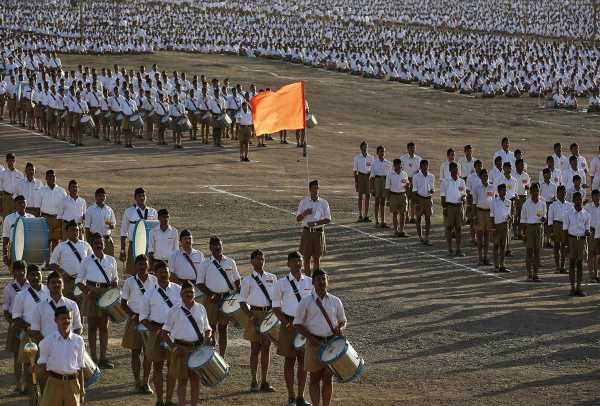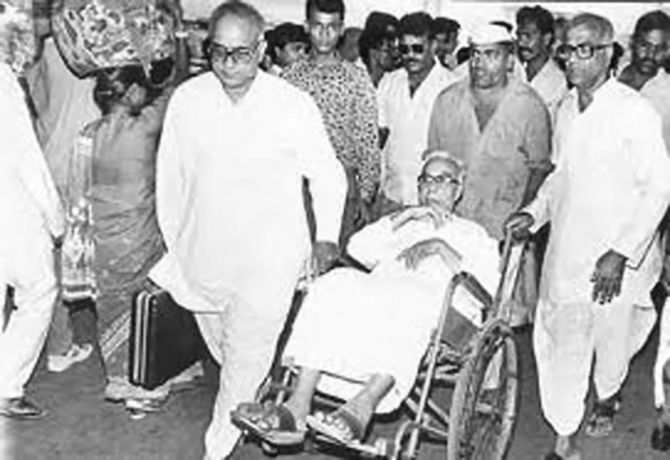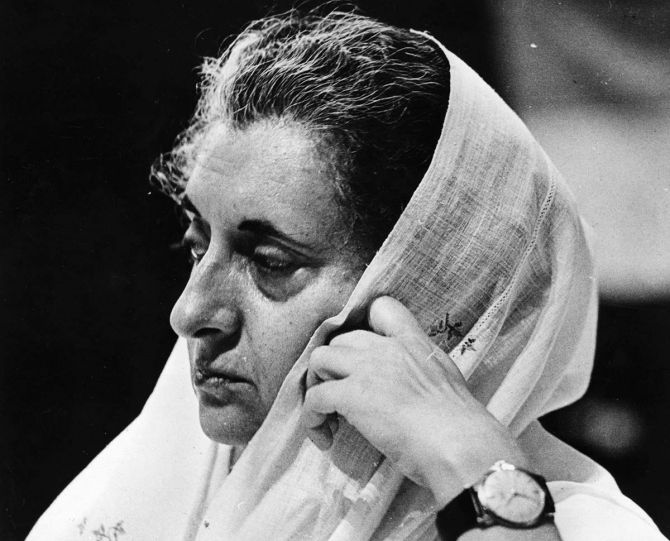The Emergency greatly influenced the RSS’ makeover from a fringe force in the Indian political imagination to one that could have its own man sworn in as prime minister in two decades’ time.
A riveting excerpt from Christophe Jaffrelot and Pratinav Anil’s India’s First Dictatorship: The Emergency, 1975-1977.
Even in the first few weeks of the satyagrahas, it was clear that the RSS was the dominant force. To a great extent this owed to its size. According to its general secretary, the RSS had some 8,500 shakhas in 1975, each with around 50-100 participants.
The total strength of the RSS, therefore, was between 425,000 and 850,000. Then there was the rest of the Sangh Parivar: The BMS, a labour union of 1.2 million in 1977; the ABVP, a student union of 170,000. There were other affiliates, too. All in all, the Parivar probably counted around 2 to 3 million members.
The deep connections of the RSS to the JP Movement helped as well: when the key protagonists of Jayaprakash Narayan’s insurgent forces came together to form the Lok Sangharsh Samiti the evening before the Emergency was declared, the Parivar was well positioned to absorb a number of central positions in the new outfit, which then grew into the nerve centre of the underground.
The Jana Sangh’s Nanaji Deshmukh was made its secretary. A large number of those detained during the Emergency — 4 per cent according to the government, 33 per cent to the Sangh — came from the RSS and its affiliates. This greatly influenced its makeover from a fringe force in the Indian political imagination to one that could have its own man sworn in as prime minister in two decades’ time.
The RSS bosses were quick to realise that the Emergency was in fact a windfall. “What could not have been achieved in twenty years will be possible in two” was the message they sent out to their cadres. This was going to be their struggle.
In good time, even the Socialists were to be found acknowledging the Sangh’s indispensability underground. “The grassroot level organisation of the RSS alone is intact. Go to them. They will help you”, Achyut Patwardhan, co-founder of the Socialist party and once a scourge of the Hindu nationalists, said to his party rank and file.
“That attitude of ‘who is not with me must be my enemy’ that has dogged the Opposition for the last thirty years finally came to end, all thanks to the quandaries we faced together because of the Emergency”, Narendra Modi, then a young pracharak, later observed. Modi, who spent this period disguised as a Sikh with the nom de guerre Prakash, not only distributed grey literature and liaised with Sanghis abroad, but escorted political fugitives, including Socialists like George Fernandes, to safe houses as well.
***
For their part, elements within the Sangh not otherwise keen on merger quickly reconciled to building bridges with the rest of the Opposition when news began to emerge of Sangh defections to the Congress. Sure enough, many in the RSS who were imprisoned under MISA returned home as changed men, becoming “active supporters of the Congress, if not its active workers.”
The Jana Sangh in Uttar Pradesh, for instance, pledged its “full support” to the government on 25 June 1976, promising not to engage in “any activity which disturbs the peace and security of the state”; thirty-four Jana Sangh MLAs in Madhya Pradesh and Uttar Pradesh crossed over to join the ruling party.
These defections were not the only sign of the Sangh Parivar’s ambivalence to the regime. Indeed, its satyagrahas and sangathan (mobilisation) represented just one half of a two-pronged strategy.
Immediately after the declaration of Emergency, on 27 June, Balasaheb Deoras, the sarsanghchalak (chief) of the RSS, wrote “a letter of guidance” to the organisation’s workers: they “should continue Sangh work in accordance with directions of those appointed for the purpose by sar-karyavaha [general secretary] Shri Madhavrao Muley.”
In essence, a new division of labour had emerged: Muley was to lead the resistance underground while Deoras himself, who was arrested on 30 June, adopted a conciliatory attitude, penning missives to the prime minister from his cell in Yerawada Central Jail, Poona.
On 22 August, Mrs Gandhi received the first instalment of his epistolary courtship:
“From the jail I listened with rapt attention to your broadcast message relayed from AIR and addressed to the nation on August 15, 1975. Your speech was suitable for the occasion and well balanced.” After the plaudits Deoras moved on to more substantial matters, regretting the ban on the RSS and the arrest of “approximately 23,000 [RSS] workers”:
“What could possibly be the right cause of banning the Sangh is difficult to assess and to attribute through the ordinance. The RSS has never done anything as [sic] might hamper the smooth running of the government, the internal security and peace of the country. The aim of the Sangh is to unite the All-India Hindu community, to organise and emulate [sic] the same. The organisation tries to discipline our society … the organisation has never advocated the cause of violence, neither it has [sic] initiated anyone to such acts … Though the field of the Sangh is limited only to the Hindu community, yet nothing is taught here against any non-Hindu society [sic] … This is my humble prayer to you that you shall kindly keep the above in view and shall lift the ban on [sic] RSS. If you think it proper, my meeting with you will be a source of pleasure to me.
Yours faithfully, Madhukar Dattareya Deoras.
No reply was forthcoming. Despite the rebuff, Deoras wrote her a second letter on 10 November, traversing the same terrain but this time laying it on thick. “Let me congratulate you as five judges of the Supreme Court have declared the validity of your election”, he crooned, before proposing to put the Sangh’s cadres at her service: “Set free thousands of RSS workers and remove the restrictions on the Sangh. If done so [sic], power of selfless work on the part of lakhs of RSS volunteers will be utilized for the national upliftment (government as well as non-government) and as we all wish, our country will be prosperous.”
When she failed to respond yet again, Deoras sought to recruit as his emissary Vinoba Bhave, whose ashram he had visited in 1973 shortly after becoming sarsanghchalak.
“The Sangh has neither been violent nor encouraged acts of violence. The main function of the Sangh is to rectify man. The RSS volunteers are asked to observe control and discipline, hence it can have no place for violence”, he wrote on 12 January 1976.
Deoras was ignored by Bhave as well. A presumably dejected Deoras then sent him yet another letter when he heard that Mrs Gandhi was scheduled to visit Paunar on 24 February.
“It is my prayer to you that you kindly try to remove the wrong notion of the prime minister about the Sangh, and as a result of which [sic] the RSS volunteers will be set free, the ban on the Sangh will be lifted and such a condition will prevail as to enable the volunteers of the Sangh to participate in the planned programme of action relating to country’s progress and prosperity under the leadership of the prime minister.”
Bhave, who was not in the least interested in picking up the cudgels on behalf of any Opposition group, whether of the Left or the Right, disappointed many of his hangers-on who had hitched their wagons to the resistance. Instead, he counselled conciliation: he was not going to allow his religious preferences get in the way of friendships of old, especially not those that had yielded him material benefit.
***
Constructive ambiguity had its uses. On the one hand, Deoras hoped he could have the ban on his organisation lifted by turning the Sangh’s cadres into the shock troops of the regime, the entryism remaking the Congress, perhaps even the nation, in its image.
On the other, Muley’s satyagrahas had indisputable propaganda value. It is no accident that the official history of the RSS in Emergency India, The People versus Emergency: A Saga of Struggle, glosses over the Deoras letters; only a version of the first is reproduced, not in full, and almost en passant at the very end of the book.
Deoras was not alone. Hans Raj Gupta, former Delhi mayor and ‘provincial RSS sanghchalak [organiser] for Jammu and Kashmir, Punjab, Chandigarh, Haryana, and Delhi’, too, wrote Mrs Gandhi a similar letter from Tihar, promising in exchange for lifting the ban the beginning of a “new era of co-operation” between the Parivar and the Congress, the former assisting the latter in its “nation-building activities”.
According to the Jana Sangh MP Subramanian Swamy, “Atal Bihari Vajpayee also wrote apology letters to Indira Gandhi, and she had obliged him. In fact for most of the 20-month Emergency, Mr Vajpayee was out on parole after having given a written assurance that he would not participate in any programme against the government.”
In November 1976 Swamy, who was abroad trying to stir up the Diaspora, was told by Muley that “the RSS had finalised the document of surrender to be signed” at the end of January 1977. “On Mr Vajpayee’s insistence”, Swamy was to be the sacrificial lamb “to appease an irate Indira and a fulminating Sanjay whose names I had successfully blackened abroad by my campaign.”
In the event, no surrender took place, hence no oblation either, for Mrs Gandhi announced a snap election on 18 January 1977.
What were the Sangh Parivar’s activities underground? After Deoras’ arrest the bulk of the RSS leadership quickly went into hiding. Swayamsevaks, the Sangh’s foot soldiers, were instructed to continue showing up at the shakhas, but in plain clothes instead of in their identifiable white shirts and khaki skirts.
On 4 July 1975, Muley invited the surviving chiefs of the Sangh — among others Bhaurao Deoras (brother of the sarsanghchalak), Rajendra Singh, Sunder Singh Bhandari, Dattopant Thengadi, Nanaji Deshmukh, and Moropant Pingle — to his residence to take stock of the situation.
It transpired that virtually the entire RSS machinery was intact. It had certainly helped that on 25 June 1975 itself, some of the RSS leaders had “come to know of what was coming”, as the Jana Sangh’s Deshmukh later admitted.
Only one prant pracharak (provincial organiser) and 189 of the RSS’ 1,356 pracharaks (full-time organisers) had wound up in prison. The rest were safe underground, occasionally resurfacing at the numerous “summer camps” that the organisation held as part of its routine activities.
Indeed, the chain of command was uninterrupted: Directives flowed from Nagpur, the Sangh’s headquarters, to the prant pracharaks, who passed them on to the vibhag pracharaks below them, who in turn relayed them further down to the district and tehsil levels — all in the span of a few days.
Despite the strength of its clandestine networks, the RSS preferred not to fight the Emergency on its own. At an August 1975 meeting that brought its tactical positions into sharper relief, its leaders reasoned that while “the RSS had the capacity to save democracy by itself”, going it alone risked a post-Emergency settlement that was a democracy only in a formal sense: A hegemonic Congress confronting a gaggle of Opposition parties on the verge of extinction. How, then, were the “defunct political parties [to] be revitalized?”
In the main by the RSS. “Thus, the Sangh had to work on two fronts. On the one hand it had to revitalize Opposition parties and on the other organise a strong public opinion for the re-establishment of democracy. Hence the decision of the RSS to conduct all activity in the name of the Lok Sangharsh Samiti.”
But democratic rule was not an end in itself. The Sangh’s commitment to representative government, as Dattopant Thengadi inadvertently argued in his preface to the Sangh’s official history, was only skin-deep:
“It is accepted on all hands that the present democratic process in India is not a growth of the soil and it is neither adequate nor favourable nor capable [sic] from the point of view of conditions in and requirements of the country. But its protection can save the country from dictatorship. It can afford scope for the thinking and action necessary for a new system that accords with the tradition, nature and circumstances of the country. In a dictatorship this is not possible. So opposing the dictatorship of the Emergency became a natural duty of the Sangh.”
In the event, the question was settled in favour of coalition politics. The LSS’ secretary was Nanaji Deshmukh — until his arrest in August 1975 — and the better part of its cadres were Sanghis. So it was decided by RSS leaders and pracharaks in Delhi that the LSS was the perfect barque for capture.
Liaising with the Samiti was bound to bring it into contact with a large spectrum of Opposition politicians — just as the Parivar’s involvement in the JP Movement had in the run-up to the Emergency.
This edited excerpt from India’s First Dictatorship: The Emergency, 1975-1977 has been used with the kind permission of the publishers, Penguin Random House India.
Source: Read Full Article






